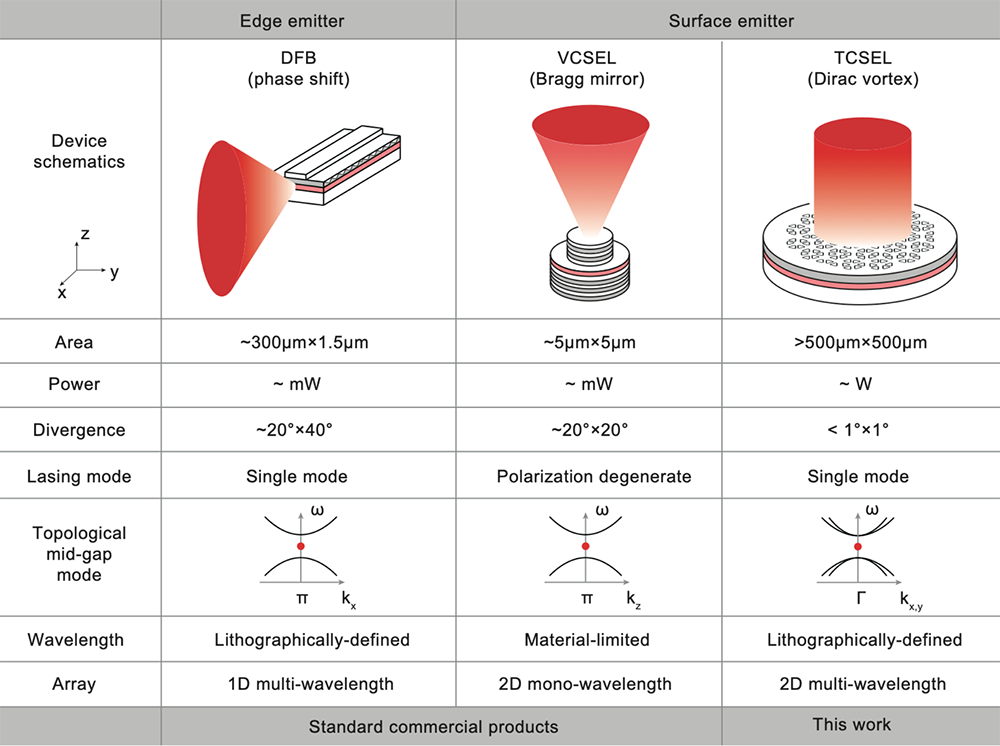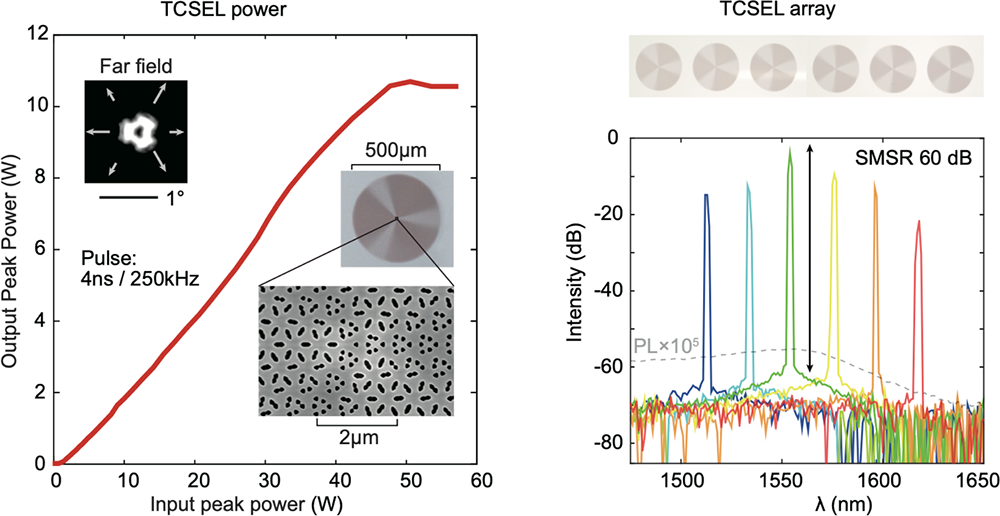Topological-cavity surface-emitting laser
Date:05-05-2022 Print
Semiconductor lasers are the most widely used lasers in our daily lives for their compact size, high efficiency, low cost, and wide spectra. But they suffer low output power and low beam quality --- two specifications difficult to improve simultaneously. For example, although a larger cavity increases power, it supports more modes to lase which decreases beam quality. Previously, a new cavity named "Dirac-vortex topological cavity" was demonstrated, by the L01 group at Institute of Physics of Chinese Academy of Science led by Prof. Ling Lu, which offers the best single-mode selection over the largest area. This cavity design was proposed to overcome the above-mentioned bottlenecks of semiconductor lasers and simultaneously improves the output power and beam quality. Recently, the same team applied their topological cavity to surface emitting lasers and invented the topological-cavity surface-emitting laser (TCSEL), whose performance can far exceed that of the commercial counterparts in Fig. 1. In their report published in Nature Photonics, TCSEL is capable of 10W peak power, sub-degree beam divergence, 60dB side-mode suppression ratio, and 2D multiwavelength array, lasing at 1550nm --- the most important communication and eye-safe wavelength. TCSEL can also operate at any other wavelength range and is promising for a large variety of applications, including LiDAR for face recognition, self-driving, and virtual reality.

Fig. 1 | Comparison of TCSEL with mainstream commercial single-mode semiconductor lasers.
We compare TCSEL with the standard industrial products of single-mode semiconductor lasers in Fig.1. The distributed feedback (DFB) edge-emitting laser used in Internet communication as well as the vertical-cavity surface-emitting laser (VCSEL) enabling cell-phone facial recognition both adopt the mid-gap mode in their optimized 1D resonator designs. TCSEL continues this successful path by realizing the 2D version of topological mid-gap mode that are more suited for the planar process on semiconductor chips.

Fig. 2 | TCSEL performance and array.
Large area single mode is a unique feature of TCSEL, which improves the peak power (>10W) and beam divergence (<1degree). In contrast, the output of commercial DFB is generally on the order of tens of mW and the output of a single VCSEL is a few mW; the typical divergence angle of surface emission is 20° and the beam of the edge emitter is generally worse. Fig. 2 (left) shows the optical microscope and scanning electron microscopy images with the device diameter of 500 μm. The iconic vortex structure, from the Dirac-vortex cavity, can be seen clearly. The far field of TCSEL is a vector beam with radial polarizations. Importantly, such a narrow divergence (sub-1°) of TCSEL, without collimating lenses, can reduce the system size, complexity and cost in systems such as 3D sensing.
Wavelength flexibility is another unique feature of TCSEL, such as the ability to achieve monolithic 2D multi-wavelength arrays. In comparison, VCSEL generally lacks wavelength tunability since the vertical cavity, determining the lasing wavelength, is epitaxy grown. Although DFB laser can adjust the wavelength, it can only achieve 1D multi-wavelength array for edge emission. In contrast, the wavelength of TCSEL can be arbitrarily adjusted during the planar fabrication process. In Fig. 2 (right), by changing the lattice constant, the corresponding laser wavelength varies linearly from 1,512 nm to 1,616 nm. Each laser in the 2D array works stably in a single mode with a side mode suppression ratio greater than 50dB. The 2D multi-wavelength TCSEL arrays can potentially enhance the wavelength-division multiplexing technology for high-capacity signal transmission and multi-spectral sensing applications.
Topological physics has been the focus of fundamental research since the discovery of the quantum Hall effect and was awarded three Nobel physics prizes (1985, 1998, 2016). Although topological robustness could significantly improve the device stability and specifications, the application of topological physics remains elusive. TCSEL could make a difference.
The authors of the paper are Dr. Lechen Yang, Dr. Guangrui Li, Dr. Xiaomei Gao, and Professor Ling Lu from Institute of Physics, Chinese Academy of Sciences. The fabrication of TCSEL was completed in the Laboratory of Microfabrication of Institute of Physics. This work is supported by the Chinese Academy of Sciences, Beijing Natural Science Foundation, Ministry of Science and Technology, and Natural Science Foundation of China.
Contact:
Institute of Physics
Ling Lu
Email:linglu@iphy.ac.cn
Key word:
Topological photonics; semiconductor laser
Abstract:
Researchers invent the topological-cavity surface-emitting laser having superior performance figures compared with the commercial semiconductor counterparts.

